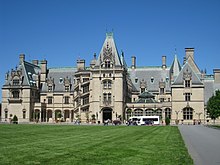Richard Morris Hunt

Richard Morris Hunt (born October 31, 1827 in Brattleboro , Vermont , † July 3, 1895 in Newport , Rhode Island ) was an American architect. He belongs to the Vermont family Hunt .
Life

Richard Morris Hunt was the fourth of five children of Congressman Jonathan Hunt and his wife Maria Jane Leavitt. His mother came from an influential Connecticut family . After the early death of his father, he grew up with his siblings, including his older brother William , in Switzerland and France .
Richard Morris Hunt was the first American to study architecture , painting and sculpture at the École des Beaux-Arts in Paris . After his return to New York City , he was soon considered the most prominent architect in the city. Early in his career, Hunt designed a number of avant-garde buildings that brought French architectural ideas to America. Hunt received several important commissions during his career, including the design of the first skyscraper , the Tribune Building (1876), the entrance wing of the Metropolitan Museum of Art (1895-1902), the base for the Statue of Liberty (1881-1885) and the World Columbian Exposition Administration Building (1891-1893). He was the discoverer and patron of the Austrian sculptor Karl Bitter .
Richard Morris Hunt was married to Catherine Howland, on whose Hilltop Estate the couple lived. The marriage, which all reports said was a happy one, remained childless. He died of a heart attack . In Central Park , a landscape park in New York City, it was erected in honor of a monument. The responsible artist was the sculptor Daniel Chester French (1850–1931).
Building (selection)
- 1870–1873 Stuyvesant Building in New York
- 1873–1874 Roosevelt Building in New York
- 1873–1876 New York Tribune Building in New York
- 1879–1883 Cornelius Vanderbilt II's mansion on Fifth Avenue in New York
- 1893–1895 Cornelius Vanderbilt II's The Breakers in Newport
- 1888-1892 William K. Vanderbilt's Marble House in Newport
- 1888–1895 George Washington Vanderbilt II Biltmore Estate in Asheville
Honors
- Member of the Royal Institute of British Architects , London
- Member of the Royal Academy of Arts , London
- Member of the Académie des Beaux-Arts , Paris (1893)
literature
- Susan Stein: The Architecture of Richard Morris Hunt. University of Chicago Press, 1986, ISBN 0-226-77169-5 .
- Paul R. Baker: Richard Morris Hunt. The MIT Press, 1986, ISBN 0-262-52109-1 .
- John Foreman and Robbie Pierce Stimson: The Vanderbilts and the Gilded Age: Architectural Aspirations, 1879–1901. St Martins Press, 1991, ISBN 0-312-05984-1 .
- A. Lewis: American Country Houses of the Gilded Age (Sheldon's "Artistic Country Seats"). Dover Publications, 1982, ISBN 0-486-24301-X .
- John Vredenburgh van Pelt: A monograph of the William K. Vanderbilt house: Richard Morris Hunt. JV van Pelt, 1925.
Web links
- Biography on fs.fed.us (English)
- Biography xroads.virginia.edu (English)
| personal data | |
|---|---|
| SURNAME | Hunt, Richard Morris |
| BRIEF DESCRIPTION | American architect |
| DATE OF BIRTH | October 31, 1827 |
| PLACE OF BIRTH | Brattleboro , Vermont |
| DATE OF DEATH | July 3, 1895 |
| Place of death | Newport , Rhode Island |

